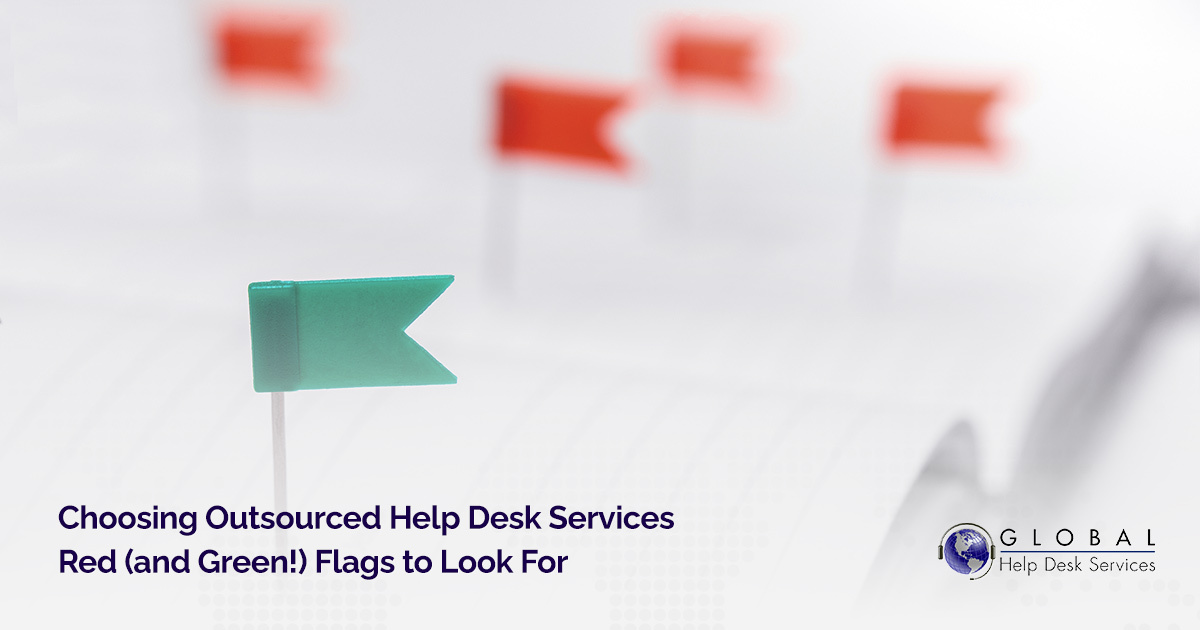When you’re researching potential IT help desk outsourcing vendors, you’ll digest a lot of information. Between talking to company representatives, reading reviews, and pulling together the results of a dozen browser tabs’ worth of research, you’ll feel like you’re drinking from the information firehose.
If only all that information could guarantee the right decision. But sometimes, a vendor looks great on paper, only to be a really, really bad fit … and the signs are obvious only in the rearview mirror.
To avoid buyer’s regret when choosing an IT help desk outsourcing company, here are some red flags that could signal an uphill battle with your IT help desk services provider — and some green flags that let you know the provider could be the perfect fit for your needs.
Choosing an Outsourced IT Help Desk: Red Flags
Obviously, red flags signal danger. While one or two bad signs could be explained away, more than that should make you reconsider, or at least dig into your concerns and how the company plans to address them. Here are a few to look out for:
The Red Flag: You Get a Price Without a Detailed Discovery
They give you a price up front, without finding out your unique needs.
Why it should scare you: The discovery process can be long. So, cutting it out is a big win, right? Wrong. If you’re given a price without the provider knowing details about your call volume, talk time, and other needs, alarm bells should go off. That means you aren’t getting a solution built especially for your needs.
Rather, the company is choosing one of their ready-made solutions from a menu of offerings and trying to cram your needs into it, like a round peg into a square hole. You might not get the coverage you need or the knowledge base required to answer your users’ questions. And you may not be able to scale up or down when your call volume changes.
Note: It isn’t uncommon for help desk outsourcing vendors to have call volume minimums. So, if your needs fall beneath these minimums, you may be charged a bit more than your actual call volume to meet them, but that should all be clearly explained to you before you sign on the dotted line.
Read more: Considering Outsourcing Your Help Desk Services? Here’s What to Expect
The Red Flag: A Lack of Flexibility
The company doesn’t offer options to scale support up or down when your call volume changes.
Why it should scare you: If your provider is too rigid in their contracts, your caller experience will suffer. When call volume increases, your callers will experience long wait times. When your call volume drops, you’ll be paying for coverage you don’t need. So be sure to ask potential IT help desk outsourcing partners how they will adapt to changes in your call volume and other needs.
The Red Flag: A Lack of 24/7 Support
Instead of providing employee coverage on every shift, some IT help desk vendors rely on after-hours outbound paging of agents.
Why it should scare you: If you need 24/7 coverage, you need staff that works every shift. Your late-night callers don’t want to wait for an agent to be roused from a dead sleep to groggily answer their questions. They want the same experience that callers dialing in during the day receive. The same goes for holidays and weekends. If you’re open then, your callers expect you to be fully open, with agents ready to take their calls and answer their questions with the same attention and expertise they’d receive any other time.
Red Flag: The Help Desk Isn’t Their Main Focus
The company provides a wide range of other services, and the help desk is a small percentage of their revenue.
Why it should scare you: If the help desk is only 10% of a managed service provider’s revenue, it’s only 10% of their focus. That means you’re getting only 10% of the attention you need. Their agents may be handling other duties on top of taking calls or lacking the customer service background and skills your users require.
Or, the agents your vendor assigns could be higher-tiered than you need for the types of calls you receive, meaning you’re wasting money on an IT infrastructure expert to spend time helping someone reset a password when a lower-tier agent could easily handle the task — and much more economically, as well.
Read more: What You Want vs. What You Need: Planning Your IT Help Desk Requirements
Red Flag: A Lack of Experience in Your Sector
Though the company may have been around for several years, they’ve never worked in your particular field.
Why it should scare you: Agents might be missing knowledge essential to answer your callers’ questions. They may not have adequate training in HIPAA, security protocols, or other requirements relevant to your industry. They might not understand how crucial a specific task — like getting access to a system to finish payroll — is to your operations, so they don’t escalate the issue properly, and your employees get their checks two days late. Now you’re dealing with an unhappy workforce because your help desk lacks experience with the needs of an accounting department.
Be sure to ask about experience specific to your industry, regulations, or other needs before signing on with an IT help desk outsourcing partner.
Choosing an Outsourced IT Help Desk: Green Flags
When deciding on outsourced IT help desk service providers, you’ll also find some good along with the bad. Here are some “green flags” that should make you feel more comfortable with the help desk vendor you’re researching.
Note: A lot of green flags are simply the opposite of red-flag behavior. For example, easily being able to speak with a C-level employee to solve issues or a help desk who has deep expertise in your vertical is a sign you should feel comfortable with the IT help desk services provider.
Here are a few green flags we haven’t discussed yet:
The Green Flag: A Transparent, Clearly Defined Onboarding Process
You’re given a clear idea of the processes in place to bring on a new client. You know how they allocate resources and gain and transfer knowledge so agents can intelligently answer caller questions. You know what information they need from you and how they plan to absorb your call volume into their existing workloads.
Why it should make you feel comfortable: Bringing on a new customer can be disruptive to a help desk. You’re (probably) not their only customer, so the entire time they’re ramping up on your account, they’re still answering other calls for other companies. You want to know if this transition will go smoothly. The last thing you need is a call center that can’t adjust to a new influx of calls, resulting in long wait times and unhappy callers.
You also need to know there’s a plan in place to train agents on the knowledge they need to answer questions, triage calls, and escalate issues to provide the best possible service to you and, by extension, your callers.
Read more: Guide: How to Choose an Enterprise Help Desk IT Support Company
The Green Flag: Flexible Contracts That Allow for Scalability
It’s clearly outlined in your contract what will happen when call volumes increase or decrease.
Why it should make you feel comfortable: You’ll know you won’t have to overpay during slow periods or have long wait times during high-volume periods, and you’ll have the peace of mind that you won’t be on the hook for extra charges not outlined in your contract.
The Green Flag: Background Checks and References Are Easily Accessible
The company shares how it conducts background checks on its agents. Similarly, references from past and current customers are easy to review.
Why it should make you feel comfortable: They’re not hiding anything. You know what customers think of them, good, bad, and indifferent, and you can trust that the employees answering your calls will do so in a professional manner.
Choosing a vendor for outsourced IT help desk services can be a stressful decision – and an easy one to get wrong. So, keep your eyes peeled for red flags. Avoiding them can be your key to a hassle-free journey. From vague pricing to inflexible contracts, these warning signs signal potential roadblocks in your partnership. On the brighter side, green flags like a transparent onboarding process, flexible contracts, and accessible background checks pave the way for a smoother ride. Navigating through these indicators ensures you have a partner who understands and meets your unique needs. So, as you explore the IT outsourcing landscape, keep an eye on the flags — they might just guide you to the IT help desk haven your business deserves.
Ready to see if GHDSi might be the best fit for you?


